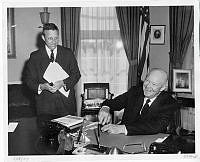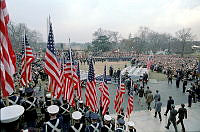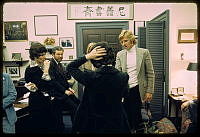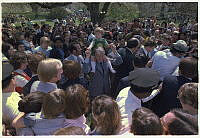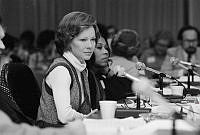Rubenstein Center Scholarship
Establishing the Herbert Hoover Presidential Library and Museum

President Herbert Hoover at the cornerstone-laying ceremony of the National Archives Building on February 20, 1933, nearly thirty years before the dedication of his own presidential repository.
National Archives and Records AdministrationWhen President Herbert Hoover laid the cornerstone of the National Archives Building in Washington, D.C., on February 20, 1933, the president told those assembled, “this temple of our history will appropriately be . . . an expression of the American soul.”1 Twenty-nine years later, President Hoover would be present at another National Archives dedication, this time of his own presidential library.

The Herbert Hoover Presidential Library and Museum, West Branch, Iowa, circa 1970, eight years after its initial dedication.
National Archives and Records AdministrationThe Herbert Hoover Presidential Library and Museum was dedicated on August 10, 1962, Hoover’s 88th birthday, in his hometown of West Branch, Iowa, in a park near President Hoover's birthplace. This was the first time he had been to his hometown in eight years. Memories of childhood returned to Hoover as he mentioned picking potato bugs as a boy for money in order to buy fireworks for the 4th of July.2 Prior to the dedication of the Hoover Library, his birthplace had already become a public site, with admission charged for tours of the home. Hoover addressed a crowd of up to 45,000 who had assembled in his hometown of 1,050. West Branch was decorated for this festive occasion with flags and bunting of red, white and blue. Six high school bands were present to welcome Hoover back home.3 The weather cooperated, and a light August breeze helped cool those in attendance.4
Former President Harry S. Truman also spoke at the event, reciprocating Hoover’s presence at the dedication of the Truman Library in Independence, Missouri.5 Truman called Hoover “a great American” with a dedication to public service “unequaled in the history of this country.” After the ceremonies, Truman approached Hoover’s son, telling him “Didn’t your dad make a great speech. It hit me right where I live.”6 Hoover was awarded two honorary degrees during the ceremonies, one from the University of Missouri and the other from Washington University in St. Louis.7

Former presidents Harry S. Truman and Herbert Hoover attend the dedication of the new Hoover Presidential Library, August 10, 1962
Herbert Hoover Presidential Library and Museum/NARAAlthough the first chronological president with a library under the auspices of the National Archives and Records Administration, the Hoover Library was the fourth presidential library established. This library was preceded by the Franklin D. Roosevelt, Harry S. Truman, and Dwight D. Eisenhower presidential libraries. Before the 1955 Presidential Libraries Act, which established the modern Presidential Libraries system, many presidents gave their administration’s papers to the Library of Congress or other repositories. Hoover, for example, originally intended his papers to go to his alma mater, Stanford University, expanding on an existing collection that served as the foundation for today’s Hoover Institution, before deciding to expand an already planned museum in his hometown into a larger library.8
The Herbert Hoover Presidential Library and Museum today is a rich resource not only for those interested in the presidency of Herbert Hoover, but also his dedication to humanitarian efforts throughout his life, his embrace of technological innovation, and the public role of his wife, First Lady Lou Henry Hoover.9

Landscape surrounding the Herbert Hoover Presidential Library and Museum, West Branch, Iowa, circa 1970.
National Archives and Records Administration







